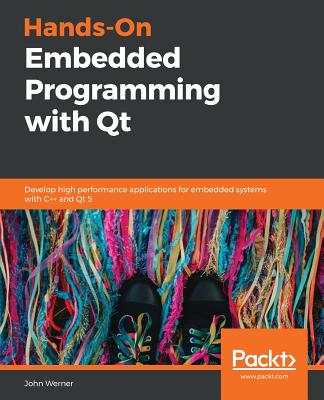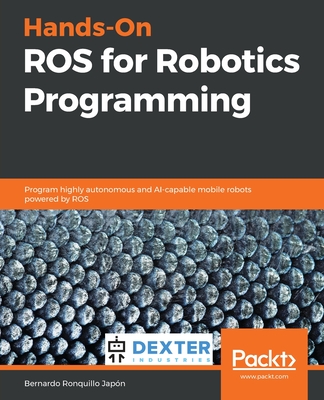Learning Robotics using Python: Design, simulate, program, and prototype an autonomous mobile robot using ROS, OpenCV, PCL, and Python, 2nd Edition
暫譯: 使用 Python 學習機器人技術:設計、模擬、編程及原型製作自主移動機器人,使用 ROS、OpenCV、PCL 和 Python,第二版
Lentin Joseph
- 出版商: Packt Publishing
- 出版日期: 2018-06-27
- 售價: $1,580
- 貴賓價: 9.5 折 $1,501
- 語言: 英文
- 頁數: 280
- 裝訂: Paperback
- ISBN: 1788623312
- ISBN-13: 9781788623315
-
相關分類:
機器人製作 Robots
-
相關翻譯:
機器人系統設計與製作:Python語言實現(原書第2版) (簡中版)
立即出貨 (庫存=1)
買這商品的人也買了...
-
 Multiple View Geometry in Computer Vision, 2/e (美國原版)
Multiple View Geometry in Computer Vision, 2/e (美國原版)$4,400$4,180 -
 程式設計師的自我修養-連結、載入、程式庫
程式設計師的自我修養-連結、載入、程式庫$580$493 -
 深入淺出 Linux TCP/IP 協定核心
深入淺出 Linux TCP/IP 協定核心$520$442 -
 Symmetry and the Standard Model: Mathematics and Particle Physics (Hardcover)
Symmetry and the Standard Model: Mathematics and Particle Physics (Hardcover)$6,780$6,441 -
 Modern Particle Physics (Hardcover)
Modern Particle Physics (Hardcover)$3,400$3,332 -
 Modern Elementary Particle Physics: Explaining and Extending the Standard Model, 2/e (Hardcover)
Modern Elementary Particle Physics: Explaining and Extending the Standard Model, 2/e (Hardcover)$1,460$1,431 -
 $450視覺 SLAM 十四講:從理論到實踐
$450視覺 SLAM 十四講:從理論到實踐 -
 為你自己學 Git
為你自己學 Git$500$390 -
 $414ROS 機器人高效編程, 3/e (Effective Robotics Programming with ROS, 3/e)
$414ROS 機器人高效編程, 3/e (Effective Robotics Programming with ROS, 3/e) -
 $888OpenCV 3.x with Python By Example, 2/e
$888OpenCV 3.x with Python By Example, 2/e -
 OpenCV 3 Computer Vision with Python Cookbook
OpenCV 3 Computer Vision with Python Cookbook$1,800$1,710 -
 CMake Cookbook: Over 40 recipes enabling you to build, test, and package software for distribution using the CMake suite (Paperback)
CMake Cookbook: Over 40 recipes enabling you to build, test, and package software for distribution using the CMake suite (Paperback)$2,300$2,185 -
 FreeRTOS 內核實現與應用開發實戰指南 — 基於 STM32
FreeRTOS 內核實現與應用開發實戰指南 — 基於 STM32$594$564 -
 Hands-On Embedded Programming with Qt
Hands-On Embedded Programming with Qt$1,980$1,881 -
 使用 AWS 在雲端建置 Linux 伺服器的 20堂課
使用 AWS 在雲端建置 Linux 伺服器的 20堂課$500$395 -
 資料密集型應用系統設計 (Designing Data-Intensive Applications: The Big Ideas Behind Reliable, Scalable, and Maintainable Systems)
資料密集型應用系統設計 (Designing Data-Intensive Applications: The Big Ideas Behind Reliable, Scalable, and Maintainable Systems)$980$774 -
 Google 的軟體工程之道|從程式設計經驗中吸取教訓 (Software Engineering at Google)
Google 的軟體工程之道|從程式設計經驗中吸取教訓 (Software Engineering at Google)$880$695 -
 ROS 2 機器人編程實戰:基於現代 C++ 和 Python 3
ROS 2 機器人編程實戰:基於現代 C++ 和 Python 3$714$678 -
 計算機視覺三維測量與建模
計算機視覺三維測量與建模$414$393 -
 $347無人機傾斜攝影三維建模
$347無人機傾斜攝影三維建模 -
 ROS 機械臂開發與實踐
ROS 機械臂開發與實踐$468$445 -
 流暢的 Python|清晰、簡潔、高效的程式設計, 2/e (Fluent Python: Clear, Concise, and Effective Programming, 2/e)
流暢的 Python|清晰、簡潔、高效的程式設計, 2/e (Fluent Python: Clear, Concise, and Effective Programming, 2/e)$1,200$948 -
 14天自造量子電腦 (Python版)
14天自造量子電腦 (Python版)$539$512 -
 量子計算 Python 與 Q# 編程實戰
量子計算 Python 與 Q# 編程實戰$599$569 -
 $378Unreal Engine 5 基礎入門教程
$378Unreal Engine 5 基礎入門教程
商品描述
Design, simulate, and program interactive robots
Key Features
- Design, simulate, build, and program an interactive autonomous mobile robot
- Leverage the power of ROS, Gazebo, and Python to enhance your robotic skills
- A hands-on guide to creating an autonomous mobile robot with the help of ROS and Python
Book Description
Robot Operating System (ROS) is one of the most popular robotics software frameworks in research and industry. It has various features for implementing different capabilities in a robot without implementing them from scratch.
This book starts by showing you the fundamentals of ROS so you understand the basics of differential robots. Then, you'll learn about robot modeling and how to design and simulate it using ROS. Moving on, we'll design robot hardware and interfacing actuators. Then, you'll learn to configure and program depth sensors and LIDARs using ROS. Finally, you'll create a GUI for your robot using the Qt framework.
By the end of this tutorial, you'll have a clear idea of how to integrate and assemble everything into a robot and how to bundle the software package.
What you will learn
- Design a differential robot from scratch
- Model a differential robot using ROS and URDF
- Simulate a differential robot using ROS and Gazebo
- Design robot hardware electronics
- Interface robot actuators with embedded boards
- Explore the interfacing of different 3D depth cameras in ROS
- Implement autonomous navigation in ChefBot
- Create a GUI for robot control
Who This Book Is For
This book is for those who are conducting research in mobile robotics and autonomous navigation. As well as the robotics research domain, this book is also for the robot hobbyist community. You're expected to have a basic understanding of Linux commands and Python.
Table of Contents
- Getting started with ROS
- Understanding basics of differential robots
- Modeling the Differential Drive Robot
- Simulating a Differential Drive Robot Using ROS
- Designing ChefBot Hardware and Circuits
- Interfacing Actuators and Sensors to the Robot Controller
- Interfacing Vision Sensors with ROS
- Building ChefBot Hardware and the Integration of Software
- Designing a GUI for a Robot Using Qt and Python
- Assessments
商品描述(中文翻譯)
設計、模擬和程式設計互動式機器人
主要特點
- 設計、模擬、建造和程式設計一個互動式自主移動機器人
- 利用 ROS、Gazebo 和 Python 的強大功能來提升您的機器人技能
- 一本實用指南,幫助您使用 ROS 和 Python 創建自主移動機器人
書籍描述
機器人操作系統(Robot Operating System, ROS)是研究和工業界最受歡迎的機器人軟體框架之一。它具有多種功能,可以在不從頭開始實現的情況下,為機器人實現不同的能力。
本書首先介紹 ROS 的基本概念,讓您了解差動機器人的基礎知識。接著,您將學習機器人建模以及如何使用 ROS 設計和模擬機器人。然後,我們將設計機器人硬體並介接驅動器。接下來,您將學習如何使用 ROS 配置和程式設計深度感測器和 LIDAR。最後,您將使用 Qt 框架為您的機器人創建一個 GUI。
在本教程結束時,您將清楚了解如何將所有內容整合並組裝成一個機器人,以及如何打包軟體。
您將學習的內容
- 從零開始設計一個差動機器人
- 使用 ROS 和 URDF 建模差動機器人
- 使用 ROS 和 Gazebo 模擬差動機器人
- 設計機器人硬體電子元件
- 將機器人驅動器與嵌入式板介接
- 探索在 ROS 中不同 3D 深度相機的介接
- 在 ChefBot 中實現自主導航
- 為機器人控制創建 GUI
本書適合對象
本書適合從事移動機器人和自主導航研究的人士。除了機器人研究領域,本書也適合機器人愛好者社群。您應該具備基本的 Linux 命令和 Python 知識。
目錄
1. 開始使用 ROS
2. 理解差動機器人的基本概念
3. 建模差動驅動機器人
4. 使用 ROS 模擬差動驅動機器人
5. 設計 ChefBot 硬體和電路
6. 將驅動器和感測器介接到機器人控制器
7. 將視覺感測器與 ROS 介接
8. 建造 ChefBot 硬體及軟體整合
9. 使用 Qt 和 Python 設計機器人 GUI
10. 評估










